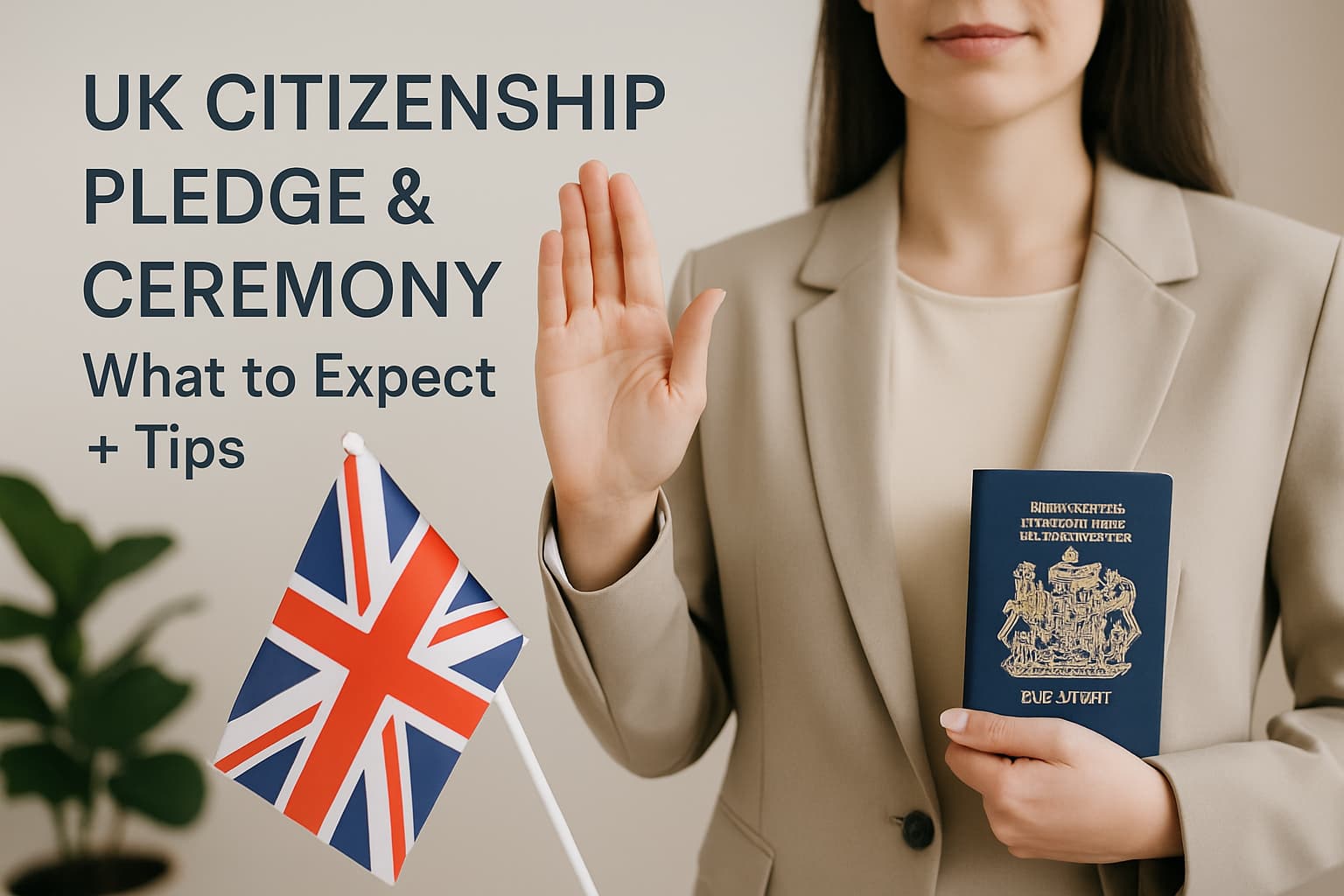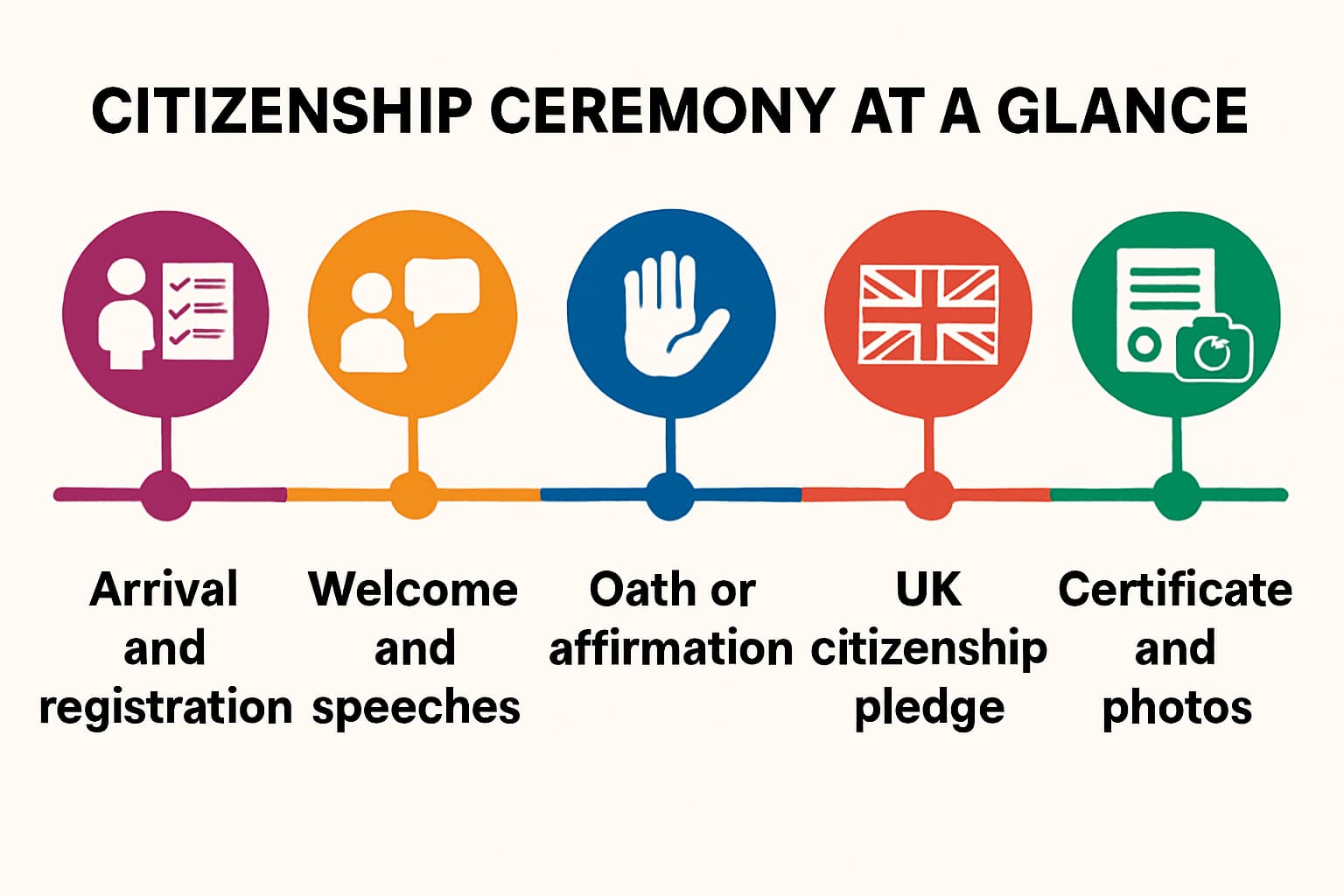UK Citizenship Pledge & Ceremony: What to Expect + Tips

Big congratulations — your approval is in, and your British citizenship ceremony is next. This guide shows exactly what happens, what you will say for the UK citizenship pledge, how to book, and what to do afterward so you arrive calm and fully prepared.
We will cover booking timelines, documents to bring, the oath or affirmation options, the exact pledge wording, and a realistic ceremony-day flow. You will also find practical tips to avoid delays and a focused way to finish Life in the UK Test prep if you are still on that step.
UK Citizenship Pledge and Ceremony at a Glance
What is the UK citizenship pledge? It is a short promise to give loyalty to the United Kingdom, respect its rights and freedoms, and uphold its laws and democratic values. You say it at your British citizenship ceremony alongside an oath or affirmation of allegiance to the King.
Who attends: Adults granted British citizenship must attend a ceremony in the UK. Children are not required but can attend if they wish.
Where: Usually at your local council (registrar’s office or civic hall).
What you say: You will make the oath (religious) or affirmation (non-religious) of allegiance, then the citizenship pledge.
Outcome: You receive your certificate of British citizenship and can then apply for a British passport.
Official guidance and the pledge wording are published by the UK government. See citizenship ceremonies on GOV.UK.

When You’ll Be Invited and How to Book
After your application is approved, you will receive an invitation to book your citizenship ceremony. You must usually book within 3 months of the invitation date with your local council. If you have not received instructions or need help finding the right office, use Find your local council.
How to schedule: Follow the booking link or details in your invitation, then contact your council to choose a date.
Formats: Group ceremonies are the standard; many councils also offer private ceremonies (faster and more personal).
Fees: Group ceremonies are often included; private ceremonies typically have an extra fee. Check your council’s page.
Rescheduling: If you need to change your slot, contact the council as early as possible. If the 3‑month window is an issue, ask the council/Home Office about extensions.
More details about booking windows and what to expect are on GOV.UK.
Booking Your Citizenship Ceremony: Group vs Private
Choose based on your timing, budget, and how personal you want the experience to feel.
Availability: Group slots are scheduled regularly; private slots depend on staff availability and may be quicker.
Cost: Group is often free; private usually carries a council fee (varies by area).
Speed: Need an earlier date? Private ceremonies can sometimes be arranged sooner.
Guests: Group ceremonies may have guest limits; private ceremonies often allow more flexibility.
Personalisation: Private ceremonies may include extra time for photos and personal touches.
What to Bring on the Day
Invitation letter/email from the Home Office or council
Photo ID (passport, BRP, or driving licence)
Proof of address if your council requests it
Guest confirmation/passes if applicable
Any accessibility notes the council confirmed with you (e.g., interpreter arrangements)
Check your council’s instructions before attending. Some venues restrict large bags or late entry after registration.
Dress Code, Guests, Photos and Anthem
Dress: Smart or smart-casual is typical. National dress is welcomed.
Guests: Numbers vary; many councils allow 1–2 guests for group events.
Photos/video: Policies differ; in many places, photography is allowed after certificates are presented.
Anthem: Some councils play or invite singing of God Save the King; participation is optional.
Accessibility and Special Requests
Mobility access: Ask about step-free routes, lifts, and accessible seating.
Interpreter: If you need one, request in advance (policies vary by council).
Religious/non-religious preference: You can choose the oath (religious) or affirmation (non-religious). Tell the registrar beforehand if they ask.
Reasonable adjustments: Inform the council early about any needs so they can plan appropriately.
The Words You’ll Say: Oath/Affirmation and the UK Citizenship Pledge
At the ceremony, you will make an oath of allegiance (religious) or an affirmation of allegiance (non-religious) to the King, then say the UK citizenship pledge. The official wording is published on GOV.UK.
Exact Wording and Choosing Oath vs Affirmation
You can choose either version below. If your council asks before the ceremony, let them know your choice; otherwise you can tell the registrar on arrival.
Oath of allegiance (religious):
I [name] swear by Almighty God that, on becoming a British citizen, I will be faithful and bear true allegiance to His Majesty King Charles the Third, his Heirs and Successors, according to law.
Affirmation of allegiance (non-religious):
I [name] do solemnly, sincerely and truly declare and affirm that, on becoming a British citizen, I will be faithful and bear true allegiance to His Majesty King Charles the Third, his Heirs and Successors, according to law.
UK citizenship pledge (said by everyone):
I will give my loyalty to the United Kingdom and respect its rights and freedoms. I will uphold its democratic values. I will observe its laws faithfully and fulfil my duties and obligations as a British citizen.
Practice Tips to Say It Confidently
Rehearse aloud: Record yourself reading the oath/affirmation and pledge, then listen back to smooth pacing.
Underline key pauses: Mark natural breaks to help your delivery sound clear and calm.
Breathe steadily: Inhale for 4 seconds, speak a line, pause, exhale. It reduces nerves.
Check pronunciation: Practice “allegiance,” “Successors,” and “democratic.”
Glance, do not grip: Read from the card steadily without hunching over it.
What Happens on the Day: Step-by-Step Ceremony Flow
Every council runs ceremonies slightly differently, but most follow this order:
Arrival and registration: Arrive 10–20 minutes early for ID and name checks.
Welcome: A registrar or civic leader opens with a short address.
Oath or affirmation: You read it individually or together (repeat after the registrar or from a card).
UK citizenship pledge: All new citizens say the pledge.
Anthem: Some ceremonies play or sing the national anthem.
Certificate presentation: You are called to receive your certificate of British citizenship.
Photos and closing: Time for pictures; the ceremony ends.
Registration Checks and Identity Verification
Sign-in: Staff confirm your details match your Home Office approval.
ID check: Present your invitation and photo ID. If anything does not match, notify the registrar immediately.
Seating: You will be shown to your seat with other new citizens and guests.
If details differ: Minor corrections may be fixed on the day; larger issues can delay certificate handover.
Reading the Oath/Affirmation and Citizenship Pledge
Language: The ceremony is in English; ask in advance if you need help understanding.
How you read: Most councils provide a card. Some ask you to repeat after the registrar. Group reading is common.
Individual reading: Private ceremonies often invite you to read individually if you prefer.
Receiving Your Certificate and Welcome Pack
Certificate of British citizenship: Check your name, date of birth, and other details immediately.
Photos: Many councils allow photos when you receive your certificate or after the ceremony.
Local materials: Some venues provide welcome information about your council and community services.
After the Ceremony: Next Steps and Legal To-Dos
Use this quick checklist to stay compliant and move straight to your British passport.
Apply for your first British passport with HM Passport Office. See apply for a first adult passport.
Update key records: Employer, HMRC, bank, GP, university, pension provider, and any professional bodies.
Return your BRP (if you had one): You must return it after becoming a British citizen. Guidance is on return your BRP.
Passport Application and Proving Citizenship
Documents: Your certificate of British citizenship, identity documents, and photos that meet HMPO standards.
Processing: Allow several weeks and check current timelines on the HM Passport Office site.
Tip: Keep scanned copies of your certificate and ID for your records.
Update Records and Return Your BRP
Who to notify: HMRC, DVLA (if your licence details change), your employer, GP, bank, mortgage/landlord, university, insurers, and any visa sponsors.
BRP return: Follow the GOV.UK instructions carefully and return it within the required timeframe to avoid a penalty.
Name changes: If you changed your name, update it consistently across all records.
Common Pitfalls and How to Avoid Them
Missing the 3‑month booking window: Book as soon as you receive your invitation and keep a record of attempts if slots are limited.
Name mismatch on certificate: Bring the exact ID used in your application; check spellings at registration and flag issues immediately.
Forgetting required documents: Pack your invitation and photo ID the night before.
No BRP return: Set a reminder to return your BRP promptly after the ceremony if applicable.
Booking Deadlines and Missed Appointments
Book within 3 months: This is the standard rule on GOV.UK.
Missed ceremony: Contact the council immediately to reschedule. If your 3‑month window is expiring, ask about an extension.
Name Mismatches and Certificate Corrections
Check carefully on the day: Ensure your full name, date of birth, and other details are correct before you leave.
If there is an error: Speak to the registrar. Depending on the issue, they may correct it or advise how to request a reissue.
Lost or Damaged Certificate: What to Do
If your certificate is lost, stolen, or damaged after the ceremony, you can request a replacement. See replacement citizenship certificate for current fees and processing.
Real Ceremony Day Timeline: A 60‑Minute Walkthrough
Here is a simple example of how a one-hour group ceremony might run.
00:00–00:10: Arrive, security check, registration desk, ID check, seating.
00:10–00:20: Welcome speech and brief explanation of the proceedings.
00:20–00:30: Oath or affirmation reading (group or individual by row).
00:30–00:35: Citizenship pledge.
00:35–00:40: Optional national anthem.
00:40–00:55: Certificate presentation and photos.
00:55–01:00: Closing remarks and exit.
FAQs About the UK Citizenship Pledge and Ceremony
How long does a British citizenship ceremony take?
Most group ceremonies take around 45–60 minutes from registration to exit. Private ceremonies can be shorter, depending on the council’s format.
Do children have to attend the ceremony?
No. Children are not required to attend, but many councils allow them to join if families prefer. Check guest limits for group ceremonies.
Can I choose the affirmation instead of the oath?
Yes. The affirmation is the non-religious alternative to the oath. You will still say the UK citizenship pledge afterward.
Is the national anthem mandatory?
No. Some councils play or sing God Save the King, but participation is optional.
Can I get a refund if I cancel?
Policies vary by council, especially for private ceremony fees. Contact your council’s registrar office for their specific terms.
Prepare Now: Pass the Life in the UK Test on Your First Try
Passing the Life in the UK Test is a prerequisite for naturalisation. The sooner you pass, the sooner your application can be decided — and the sooner you will receive your ceremony invitation.
Why the Test Matters for Your Ceremony Date
Unlock progression: A pass certificate is required for most adult applicants.
Avoid delays: Retakes slow your application and push your ceremony date back.
Stay confident: Focused prep means less stress leading up to your uk citizenship pledge moment.
How the Life in the UK Test App Accelerates Prep
Complete handbook content: All official topics, optimised for mobile sessions.
Brit-Bear smart assistant: Get guidance on weak areas and instant clarifications.
Readiness score: See exactly when you are test-ready.
650+ questions with explanations: Learn why the correct answers are right.
Hard Mode mock tests: Realistic pressure so test day feels familiar.
Offline access: Study anywhere, anytime without losing progress.
Download and Get Started
Install the Life in the UK Test App and start focused practice now:
Finish prep, pass once, and walk into your ceremony confident and ready.